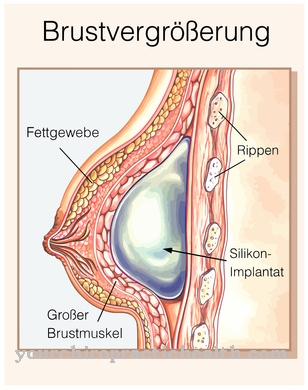The Performance diagnostics creates a performance profile through which the strengths, abilities and weaknesses of the examined patients are determined. It is a branch of medicine. This performance measurement is mainly used in sports medicine. However, there is also a psychological performance measurement. The results provide information about the physical and psychological performance that patients can achieve.
What is the performance diagnostics?

The performance diagnostics give the athlete and patient an overview of their current endurance capacity. The diagnosis records the pulse behavior, measures the strengths and weaknesses in training, carries out a spiroergometry (measurement of the breathing gases) and determines the lactate concentration in the blood.
The investigation is carried out on special ergometers and in field tests. In order to make performance diagnostics more efficient, it is important to bring any existing examination results (e.g. EKG, MRI, X-ray, ultrasound), drug lists or operation reports with you. Prior to the examination, the patient must not expose himself to any intensive training, unusual muscular exertion or competitions, as these physical stresses can falsify the examination results. The last light, low-fat meal is given two to three hours before the examination.
Goals & Basics
Performance diagnostics determine physical health as well as personal and psychological performance. A large number of different measuring pallets enable this performance survey to be carried out. Before the investigations are carried out, the question of the goal arises.
Human performance is determined by various factors such as body type, height, weight and constitution. Muscle strength, endurance, the water and electrolyte balance, the cardiovascular system, temperature regulation, breathing and metabolism are vital functions that are indispensable for the implementation of all the services that people perform on a daily basis. The mental state, the current life situation, illnesses and medication can also impair performance. The scope of the investigation varies depending on the target. In order to carry out a performance survey of athletes and high-performance athletes, more complex methods are required than if a healthy person or amateur athlete wants to get to know his range of performance and know which sports are suitable for him.
Performance diagnostics is also suitable for people with manifest diseases such as obesity, diabetes mellitus and arterial hypertension. In this way, doctors can determine how severely their performance is impaired and whether they develop new symptoms under the physical strain or whether the chosen therapy is effective. In addition to sports medicine, areas of application are primarily prevention and rehabilitation. Exercise therapy care is induced for these patients. In order to prescribe a suitable and health-promoting exercise therapy, the doctors subject the patient to a performance diagnosis, preferably by means of a lactate test or a spiroergometry (ergospirometry).
With this examination they determined the individual anaerobic threshold of the patient. Performance diagnostics are also recommended for children and adolescents who do sports in a club or training group. In school sport, the collection of these individual health data is induced, as this way any existing but previously undiscovered weaknesses (e.g. in motor skills) can be counteracted in good time through sensible therapeutic measures. Athletes who opt for a demanding, individual sport such as mountain climbing, paragliding, marathon or rock climbing are advised to have an individual performance survey carried out.
Diagnosis & examination methods
Large motor movement coordination is the fundamental psychophysical skill that enables people to learn and perform all movements and sports. This coordination controls the interaction of all other movement components. It forms the basis for a meaningful performance survey.
The patient brings sports equipment and sneakers with him to carry out the performance diagnostics, as the doctors carry out the examination using various types of training. In order to be able to optimally transfer the test data to the training being carried out, the sports medicine specialists carry out sport-specific analyzes on ergometers (ergometry) specially designed for performance diagnostics under laboratory conditions. Cyclists and triathletes complete bicycle ergometry on high-performance ergometers. Treadmill ergometry is used for triathletes, runners and ball athletes. Rowers undergo the rowing ergometry (Concept II), canoeists, boxers and disabled athletes use the hand crank ergometry.
The treadmill, bicycle and rowing check includes a general health check-up, body fat determination, lung function diagnostics with parallel breath analysis, an EKG, a urine test, a lactate test and blood pressure behavior during exercise, rest and recovery. Field tests are carried out for groups for runners, swimmers and all game sports. In the field test, a lactate level test determines the muscular strain on the athletes. On this basis, the individual training heart rate is determined, which enables targeted training control. The athletes are loaded to their limits with a gradual increase in speed. At the end of each training frequency, a drop of blood is drawn from the patient's earlobe (capillary) to measure lactate.
At the same time, the heart rate is measured during the entire training session. In the field test, constant routes are used under real conditions (e.g. stadium laps, running routes). Several athletes are examined at the same time. This test is therefore well suited for performance diagnostics in team sports. Then the running speed, the pulse rate and the lactate level in the blood are measured. The lactate curve can be used to determine the individual heart rates for interval training, endurance training or fat metabolism training. The field test is used for important diagnostics before a competition, the preparation of a competition phase and season preparation. The effects of endurance training can be determined through repetition, so that performance can be built up over a long period of time.
An improvement in performance in the anaerobic and aerobic area can be demonstrated. The "body coordination test" (KOT) is carried out on children and adolescents between the ages of 5 and 14. The “Vienna Coordination Course” covers the performance spectrum of young people between 11 and 21 years of age. This test is preferably carried out during proficiency tests at scientific universities (sports studies) and sports high schools. Applicants for military and police service must also undergo this performance survey.
Molecular performance diagnostics identifies genetically determined parameters of athletic performance and deals with the regulation and influence of cellular signaling pathways through endogenous and exogenous influences. It serves to optimize performance and records the presence of different ACTN3 molecules that affect the predisposition to become endurance athletes or sprinters. In the field of weight training, performance diagnosis takes place through isokinetic muscle strength measurements, force plates, distance and time meters, acceleration sensors and dynamometers.
Another sub-area is psychological performance diagnostics, which are mainly used in vocational preparation and pre-vocational measures as well as in reintegration. The doctors carry out the cognitive performance potential as well as manual motor tests. In the orienting school performance test, basic knowledge of German and mathematics is assessed.Problem areas are recorded through psychological questionnaires.













.jpg)

.jpg)
.jpg)











.jpg)